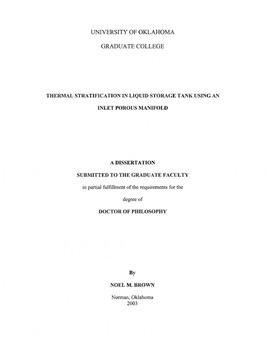| dc.contributor.advisor | Lai, Feng C., | en_US |
| dc.contributor.author | Brown, Noel Marcelious. | en_US |
| dc.date.accessioned | 2013-08-16T12:19:04Z | |
| dc.date.available | 2013-08-16T12:19:04Z | |
| dc.date.issued | 2003 | en_US |
| dc.identifier.uri | https://hdl.handle.net/11244/641 | |
| dc.description.abstract | In the second part, a storage tank was constructed. The dimensions were kept as close as possible to those used in the previous study. A number of experiments were conducted to investigate the conditions necessary for stratification. Flow visualization experiments were also conducted to evaluate the effectiveness of the inlet porous manifold in promoting and maintaining the thermal stratification. | en_US |
| dc.description.abstract | This work investigated the conditions necessary for thermal stratification in liquid storage tank. The investigation involved the fabrication and testing of a porous manifold to determine its permeability and the slip coefficient that can be used at the interface between the porous wall and the fluid layer. A full-scale model of a thermal storage tank with an aspect ratio of 4 (l/r t = 4) using an inlet porous manifold was constructed and tested. The results were compared to those obtained from a numerical model of the same tank. After validation, the numerical model was used to further investigate the conditions necessary for thermal stratification. In general, this work was carried out in three major parts. | en_US |
| dc.description.abstract | Finally, a numerical simulation of the thermal storage tank was conducted. A comparison with the experimental results was performed to evaluate the accuracy of the permeability and the slip coefficient measured in the first part of the study. It was then used to evaluate stratification at lower Richardson numbers. | en_US |
| dc.description.abstract | In the first part, fiberglass and nylon nettings were used to fabricate seven porous tubes, with various dimensions. Six tubes had an outer diameter of 1.9 cm and wall thickness ranging from 0.158 cm to 0.635 cm, and the other tube had dimensions of 10 cm outer diameter and wall thickness of 0.635 cm. The larger tube was similar to the inlet manifold used in the storage tank. Theoretical analysis for flow in a porous tube was first conducted. The solution was obtained using the slip coefficient condition at the interface between the porous wall and the fluid layer. Experiments were conducted to determine the permeability of each tube in both longitudinal and radial directions, and the slip coefficient that can be used at the interface. Due to the limitations in the present setup, the longitudinal permeability of the large tube was not measured but was estimated from a smaller tube of the same material and a similar wall thickness. | en_US |
| dc.description.abstract | Based on the results obtained, it was concluded that slip coefficient depended not only on the material but also on the Reynolds number, the permeability and the porous wall thickness. The longitudinal permeability depended on the material while the radial permeability was found to depend on the wall thickness. (Abstract shortened by UMI.) | en_US |
| dc.format.extent | xx, 217 leaves : | en_US |
| dc.subject | Solar energy. | en_US |
| dc.subject | Storage tanks. | en_US |
| dc.subject | Heat storage. | en_US |
| dc.subject | Engineering, Mechanical. | en_US |
| dc.title | Thermal stratification in a liquid storage tank using an inlet porous manifold. | en_US |
| dc.type | Thesis | en_US |
| dc.thesis.degree | Ph.D. | en_US |
| dc.thesis.degreeDiscipline | School of Aerospace and Mechanical Engineering | en_US |
| dc.note | Source: Dissertation Abstracts International, Volume: 64-09, Section: B, page: 4574. | en_US |
| dc.note | Major Professor: Feng C. Lai. | en_US |
| ou.identifier | (UMI)AAI3104295 | en_US |
| ou.group | College of Engineering::School of Aerospace and Mechanical Engineering | |
